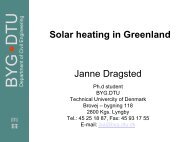1 OMAE01-PIPE4030 ABSTRACT The magnitudes of pipeline - Artek
1 OMAE01-PIPE4030 ABSTRACT The magnitudes of pipeline - Artek
1 OMAE01-PIPE4030 ABSTRACT The magnitudes of pipeline - Artek
You also want an ePaper? Increase the reach of your titles
YUMPU automatically turns print PDFs into web optimized ePapers that Google loves.
conventional recipe is about one order <strong>of</strong><br />
magnitude larger than the velocity required to<br />
move the sediment. Consequently the seabed<br />
will, for typical field conditions, become<br />
mobile long before the critical forcing<br />
conditions for <strong>pipeline</strong> stability are reached.<br />
3. STABILITY CONDITIONS UNDER<br />
WAVES<br />
Design conditions usually dictated by extreme<br />
storm wave forcing. <strong>The</strong> presence <strong>of</strong> gravity<br />
waves will, in addition to exerting<br />
hydrodynamic loads directly on the sediment<br />
and the <strong>pipeline</strong>, influence the shear strength<br />
and the bearing capacity <strong>of</strong> the seabed soil.<br />
Under certain conditions the oscillatory seabed<br />
pressure will cause liquefaction <strong>of</strong> the seabed,<br />
in which case the shear strength becomes zero.<br />
This has important implications for <strong>pipeline</strong><br />
stability since liquefaction usually is<br />
associated with sinking <strong>of</strong> an unburied<br />
<strong>pipeline</strong>. If the <strong>pipeline</strong> sinks the resistance to<br />
horizontal movements increases significantly.<br />
It turns out that a useful parameter for<br />
quantification <strong>of</strong> the wave forcing is the S<br />
parameter defined by Sleath (1994)<br />
u 0 ω<br />
S = (11)<br />
g(<br />
s −1)<br />
where u0 is the amplitude <strong>of</strong> the orbital<br />
velocity and ω isthecyclicwavefrequency.<br />
<strong>The</strong> S parameter is essentially the ratio <strong>of</strong><br />
inertia to gravity forces on sand in the seabed.<br />
Sleath found that certain aspects <strong>of</strong> oscillatory<br />
flow sediment transport were related to S. In<br />
particular, high values <strong>of</strong> S resulted in a whole<br />
layer <strong>of</strong> sand being mobilised simultaneously.<br />
Sleath called this ‘plug’ formation.<br />
3a. Sediment mobility<br />
<strong>The</strong> Shields parameter for wave motion can be<br />
expressed as<br />
2<br />
1<br />
f w u 0<br />
2<br />
θ =<br />
(12)<br />
g(<br />
s −1)<br />
d<br />
<strong>The</strong> wave friction coefficient, fw, isafunction<br />
<strong>of</strong> A/d, where A = u0/ω is the orbital particle<br />
4<br />
excursion. For rough turbulent flows an<br />
approximate relation can be based on Soulsby<br />
(1997):<br />
f<br />
w<br />
⎛ A ⎞<br />
= 1.<br />
39⎜12<br />
⎟<br />
⎝ d ⎠<br />
−0.<br />
52<br />
≈<br />
d<br />
A<br />
(13)<br />
<strong>The</strong> last expression is accurate to within<br />
approximately 10%, which is sufficient for the<br />
present ‘broad brush’ analysis. Combining<br />
Equations 11, 12 and 13 we get<br />
d<br />
S= 2θ<br />
(14)<br />
A<br />
and it follows that the critical value <strong>of</strong> S for<br />
initiation <strong>of</strong> sediment movement is<br />
d<br />
= 2θ<br />
(15)<br />
A<br />
Scr cr<br />
<strong>The</strong> curve for Scr as a function <strong>of</strong> A/d is shown<br />
in Figure 2. It has been assumed that θcr=0.06.<br />
3b. Pipeline stability<br />
<strong>The</strong> conventional model for marine <strong>pipeline</strong><br />
design is as follows. <strong>The</strong> horizontal and<br />
vertical wave-induced forces per unit length<br />
are calculated from the Morison equations:<br />
F<br />
x<br />
z<br />
=<br />
1<br />
2<br />
ρC<br />
D u<br />
1 ρ<br />
D<br />
L<br />
0<br />
2<br />
0<br />
u<br />
0<br />
π<br />
+ ρC<br />
4<br />
M<br />
D<br />
2<br />
∂u0<br />
∂t<br />
(16a)<br />
F = C D u<br />
(16b)<br />
2<br />
where Fy is positive upwards, d is diameter, ρ<br />
is water density., and CD CL and CM are<br />
coefficients. As before, the contact between<br />
the <strong>pipeline</strong> and the seabed is idealised as<br />
governed by Coulomb friction with a<br />
coefficient µ. In the equation for Fx, the first<br />
‘drag’ term dominates when the Keulegan-<br />
Carpenter number A/d is large, and the second<br />
‘inertia’ term when A/d is small.<br />
Suppose that only the inertia term is important.<br />
<strong>The</strong> submerged weight <strong>of</strong> the <strong>pipeline</strong> is<br />
(π/4)(sp-1)ρgd 2 ,wheresp is the relative density<br />
<strong>of</strong> the <strong>pipeline</strong>. We can define a <strong>pipeline</strong><br />
Sleath number





